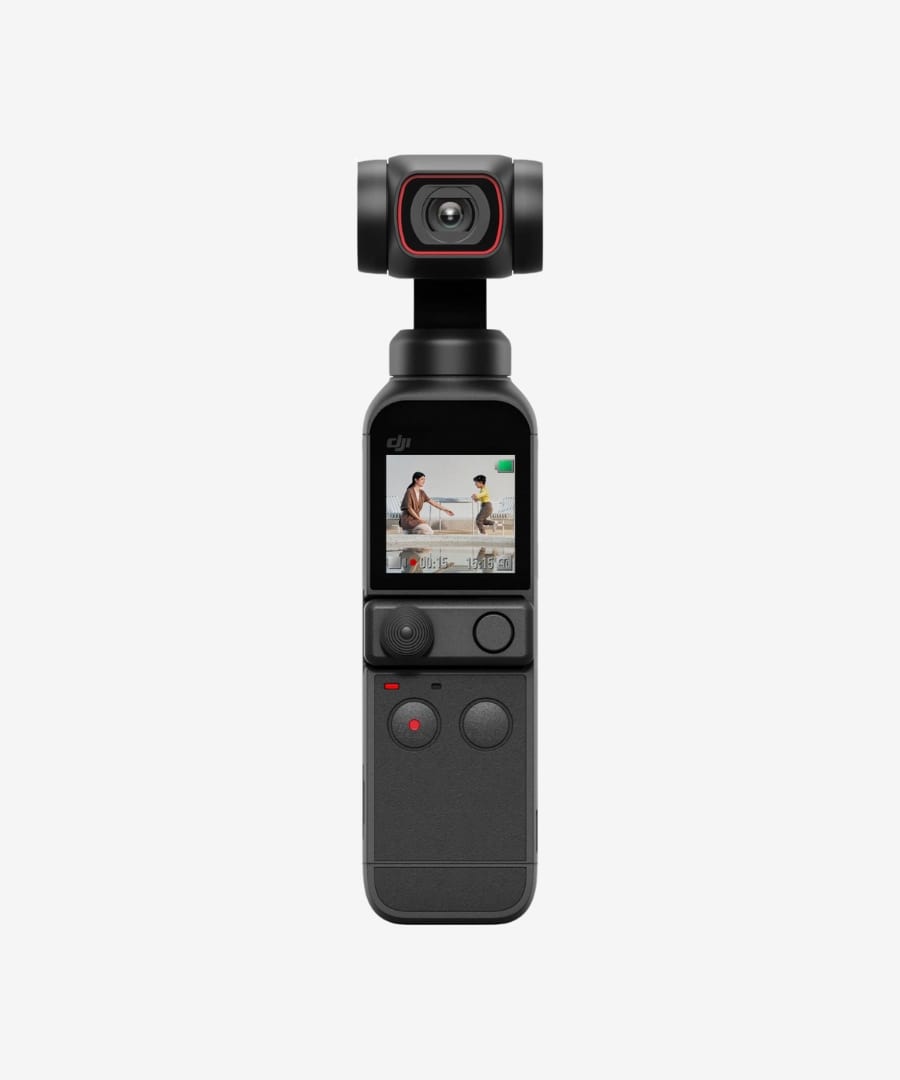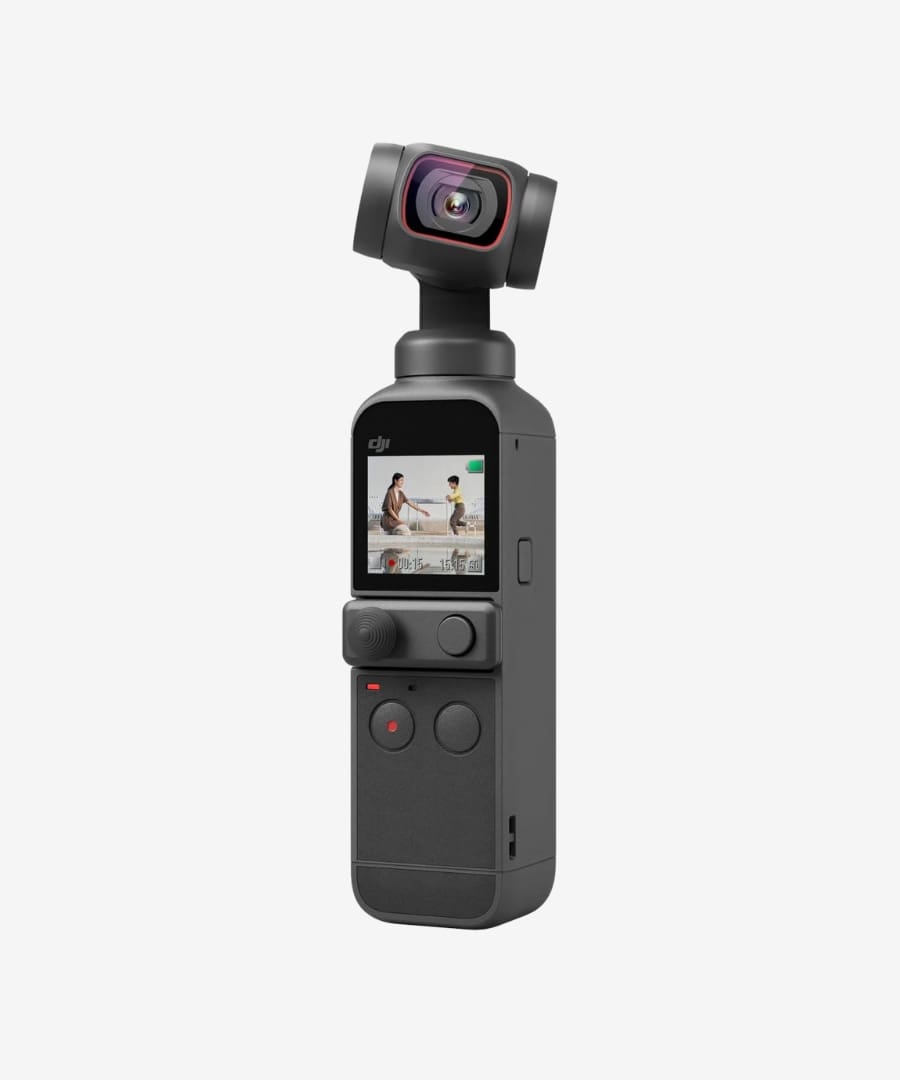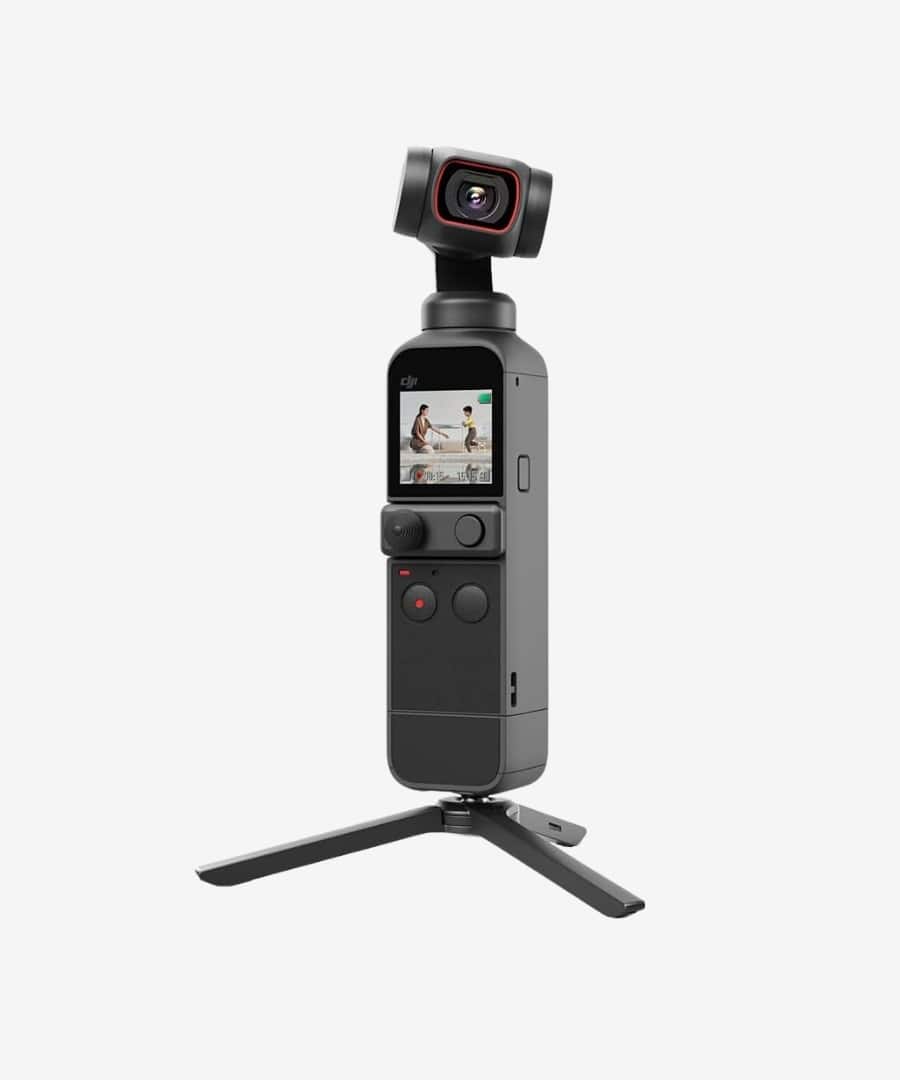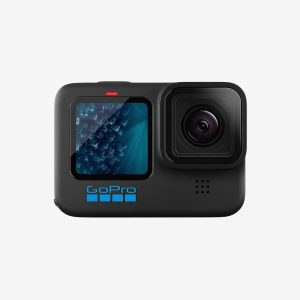The DJI Pocket 2 fits a new 64MP camera into a tiny 117-gram body. This pocket-sized wonder caught my attention when I first found it. After extensive testing of this $349 vlogging camera, I found many aspects to think over beyond the impressive numbers.
The 4K/60fps recording and professional-grade stabilization system make it appealing to content creators. My testing revealed strengths and limitations that most reviewers rarely mention. The upgraded 1/1.7″ CMOS sensor and F1.8 lens show just a glimpse of its capabilities.
My hands-on experience with the Pocket 2 will help you make an informed choice. The review covers its four-microphone audio system and 140-minute battery life. You’ll know if this portable camera belongs in your vlogging toolkit.
Real-World Vlogging Performance
My daily use of the DJI Pocket 2 over several months has shown that it works best in challenging shooting conditions. The upgraded 1/1.7-inch sensor combined with F1.8 aperture produces impressive results even in dim lighting.
The 20mm focal length is perfect to vlog with. It strikes an ideal balance between subject focus and background context. The auto-focus system works exceptionally well, especially when you adjust exposure and ISO settings as lighting conditions change.
This camera stands out because of its stabilization capabilities. The 3-axis gimbal system creates remarkably smooth footage in walking shots. It also keeps subjects perfectly framed with Active Track 3.0, so you don’t need a camera operator.
The audio performance really stands out to me. The four-directional microphones pick up clear, directional sound. Your subject’s voice stays crisp and clear as the system automatically adjusts audio improvement based on where the camera points.
These practical techniques work best in low-light shooting:
- Mounting on the included micro tripod to take long exposure shots
- Using the gimbal’s stabilization to get crisp, blur-free footage
- Adjusting exposure settings through the user-friendly controls
The real magic shows up in daily vlogging. This pocket-sized powerhouse weighs just 117 grams and captures 4K footage at up to 60 frames per second. The footage combines smoothly with content from professional cameras, which makes it a great B-roll option for complex productions.
My tests show the DJI Pocket 2 performs better than smartphone gimbals in both image quality and stabilization. Its larger sensor and professional-grade stabilization create footage that looks remarkably polished, especially in challenging lighting conditions where smartphones usually struggle.
Daily Vlog Friendly

My DJI Pocket 2 takes just seconds to set up for daily shoots. It has become my favorite camera for spontaneous content creation. The user-friendly menu system lets me switch between different modes quickly, and the camera powers up right away when I need to catch unexpected moments.
I love how the modular design fits into my daily workflow. Taking off the bottom part of the handle lets me add different accessories to expand my creative options. The Do-It-All handle makes the device longer but gives me a better shooting experience.
These practical features have made my daily shooting routine much smoother:
- Auto-switching to vertical mode for social media content
- Quick subject tracking with ActiveTrack 3.0
- Instant pairing with wireless mics
Shooting with this device is fun, and people always get curious when I take it out. I learned the controls in just a few minutes and started capturing better footage than my smartphone, while keeping it just as easy to use.
This camera works great for content creators who want stable footage without lugging around heavy gear. It really shines during walk-and-talk sequences. The wider 93-degree view helps me capture more background in my vlogs, which makes storytelling much better.
After getting comfortable with the simple controls, I found Pro Mode lets me adjust advanced settings like ISO and shutter speed. Story Mode’s preset movements and color profiles make creating social media content easy.
The Pocket 2 never leaves my side now. The built-in screen might be small for framing shots, but using the device feels natural. Connecting to the Mimo app opens up more creative possibilities, especially when I need my phone as a monitor for precise framing.
This pocket-sized camera proves its worth every day and fits anywhere – pocket, bag, or purse. It might be small, but it delivers professional results that amaze me daily.
Handling and Controls
The DJI Pocket 2’s full potential comes alive when you know its physical controls well. You’ll find the power button on the right side and the microSD card slot on the left. It takes just one second to power up, so you won’t miss those spontaneous moments.
The control layout is simple with two main buttons – one works as record/shutter and the other switches between photo and video modes. A game-changing feature I found lets you pause recording by pressing and holding the record button.
The Mini Control Stick is essential for precise camera movements. This compact joystick gives you quick control over:
- Camera direction adjustments
- Zoom functionality
- Switching between Tilt Lock, FPV, and Follow modes
The touchscreen works as your command center. A swipe up shows gimbal settings, while swiping down opens the main settings menu. Pro mode gives you detailed control of exposure, white balance, and focus settings.
The gimbal control system is versatile. You can adjust the tilt axis by hand or use the Mini Control Stick for fluid movements. Three follow modes are available – Fast Follow reacts quickly for dynamic shots, while Slow Follow creates smoother, cinematic movements.
The Gimbal Lock mode stands out – just press and hold the function button to activate it. This keeps the camera position fixed whatever the handle movement, which works great for static shots or straight-line tracking.
The Do-It-All handle makes control options better with its built-in Wi-Fi module, audio jack, and tripod mount. The touchscreen lets you quickly access other shooting modes like slow-motion, timelapse, and panorama.
Pro mode settings help fine-tune key parameters to get professional results. You can adjust exposure, white balance, and focus options for both photos and videos. The interface makes it easy to switch between mono and stereo audio channels.
The design features a textured front for better grip and a rubberized thumb rest near the buttons. While the boxy shape might feel a bit awkward with larger hands, its compact size focuses on portability without losing functionality.

Display and Design
The DJI Pocket 2’s physical design caught my attention with its compact size of 124.7×38.1×30 mm. You can get it in two colors:
- Classic Black (available standalone or with Creator Combo)
- Sunset White (exclusive combo with Do-It-All Handle)
A 1-inch touchscreen serves as the main control interface. The screen responds well and lets you adjust settings and review footage quickly. You can easily access features like white balance, shutter speed, and ISO controls.
The modular design makes this device special. Its removable base plate lets you attach different accessories to expand your creative options. This design is a great way to get more flexibility when connecting accessories like wireless microphone receivers or extension rods.
The camera shows smart engineering – its head turns inward to protect the lens when turned off. The plastic build keeps the weight at just 117 grams, making it lighter than your average avocado.
The front surface has a rough texture that helps you hold it steady while shooting. The boxy shape might not suit users with larger hands, but a rubberized thumb rest near the buttons helps with grip.
I like the new wrist strap attachment point built right into the camera body instead of the carrying case. The protective case works great for transport, though you can’t use it while filming.
The 3-axis gimbal feels solid, and pairs well with the 20mm f/1.8 lens that creates cinematic shots. Four microphones sit strategically around the camera, away from where you hold it, to capture clean audio.
The design includes some smart features too. Fast Wake powers up the camera instantly, and Drop Aware technology kicks in to protect the device if it senses a fall.
Audio Quality
Sound quality can make or break a vlog. The DJI Pocket 2’s Matrix Stereo system is a real game-changer. Its four-microphone array captures 360-degree audio and tracks sound based on the camera’s position.
What really stands out is the smart audio processing. The system pinpoints sound sources perfectly, whether they come from the subject or off-screen. This creates an immersive stereo experience that feels almost like surround sound.
The Audio Zoom feature improves the viewing experience by focusing and increasing subject audio when you zoom in. The Pro controls let me choose from these directional audio modes:
- Front-facing capture
- Front and rear recording
- All-direction sound pickup
This audio setup works much better than the original Osmo Pocket’s sound system. The microphone placement is so well thought out that my hands never block them while filming. The audio field rotates smoothly with ActiveTrack as the camera follows subjects.
Wind noise reduction is a great feature to have for outdoor shooting. The built-in noise reduction filters out unwanted background sounds well, unless you’re shooting in very windy conditions. The clear audio pickup keeps voices crisp even in tough environments.
The Do-It-All Handle takes audio capabilities even further. This optional accessory lets you connect wireless microphones, which gives you better audio quality for more demanding projects.
Video Performance

The DJI Pocket 2’s video capabilities are amazing for such a small device. This camera packs quite a punch with multiple recording resolutions:
- 4K Ultra HD at 3840×2160 (24/25/30/48/50/60fps)
- 2.7K at 2720×1530 (24/25/30/48/50/60fps)
- FHD at 1920×1080 (24/25/30/48/50/60fps)
My first tests revealed a maximum video bitrate of 100Mbps that captures all the fine details in complex scenes perfectly. The camera’s 1/1.7″ sensor combined with its f/1.8 lens produces much better image quality than the previous model.
The video quality really stands out in good lighting conditions. You’ll get crisp footage with amazing detail retention. The D-Cinelike profile comes in handy during tricky lighting situations and is a great way to get more dynamic range when you edit later.
My best results came from keeping the ISO between 100-800 when using D-Cinelike. Night shots look better with the High Quality mode as it cuts down noise by a lot compared to battery saver settings.
The slow-motion features are impressive. You can shoot 1080p at both 120fps and 240fps, which creates smooth slow-motion sequences that look dramatic and professional.
Daylight shooting is where this camera really shines. Its hybrid autofocus system uses both phase-detect and contrast-detect methods to keep everything sharp even when there’s lots of movement.
Here’s what works best in mixed lighting:
- Use D-Cinelike to capture more details in highlights and shadows
- Switch to manual exposure in challenging conditions
- Keep ISO under 1600 when shooting in low light
HDR video mode works in 2.7K and FHD resolutions and helps balance exposure in high-contrast scenes. The standard video mode often gives better color gradation and detail.
The three-axis gimbal system makes every shot look stable. This mechanical stabilization beats traditional optical and electronic methods easily, giving you professional-looking results even during quick movements.
Portable and Pocket Sized Travel Camera
The DJI Pocket 2’s incredible portability makes it feel different from lugging around a small studio of professional camera gear. This tiny powerhouse measures just 124.7×38.1×30 mm and weighs only 117 grams. It’s the perfect companion for creators who love to travel.
The camera stands out because it can start shooting in under a second. You can easily slip it into any pocket, bag, or purse, so you won’t need special camera bags or extra storage space.
The modular design makes this camera even more valuable for travelers. You can attach different accessories to its detachable base, like a tripod mount or the Do-It-All handle. The wrist strap now connects directly to the camera instead of just the case, which makes it more secure when shooting on the move.
This pocket-sized powerhouse delivers professional features without the bulk of traditional cameras. The protective case has dedicated spots for all your essential gear:
- Smartphone adapters
- Wide-angle lens
- Mini Control Stick
- Micro Tripod
The Pocket 2’s brilliance shines through its simple design and compact size. While stable footage usually needs bigger gimbals, this device delivers professional results in a tiny package. Its larger sensor and wider lens capture high-quality footage without sacrificing portability.
The Pocket 2 solved my struggle between equipment size and video quality. It’s now my favorite travel camera, offering 4K video in a package smaller than most smartphones. Long shooting sessions feel easier thanks to its lightweight design, which prevents the arm fatigue you’d get with bigger cameras.
The DJI Pocket 2 Creator Combo comes with color-matched accessories ready for your adventures. Its underwater case lets you capture smooth footage up to 60 meters deep, making it perfect for both land and underwater exploration.
Battery Life
The 875 mAh LiPo battery can record up to 140 minutes at 1080p/24fps. Battery performance changes based on how you use the camera.
My DJI takes about 73 minutes to charge with a 5V/2A USB adapter. A simple LED blinking pattern shows the charging status. A single green blink means 0-24% charge. Two blinks indicate 25-49%, three mean 50-74%, and four show 75-99%. The light stays solid green for 6 seconds at 100% charge.
High-quality 4K footage drains the battery faster and makes the camera heat up. My tests showed about an hour of continuous 4K recording used around 70% of the battery. Shooting at 1080p gives me much more recording time.
My rule is to never start shooting below 15% battery. While the battery stays fixed inside, I can keep recording by plugging in a power bank. Direct AC charging during shoots isn’t ideal because the camera might overheat.
The camera works best between 0° and 40°C (32° to 104°F). Battery performance changes in extreme weather. Safe charging needs temperatures between 5° and 60°C (41° to 140°F).
Plugging in an Android phone through the smartphone adapter uses power at 5V/500mA. This cuts down the overall recording time. The optional charging case helps by providing roughly 1.5 extra full charges.
The camera’s passive cooling system handles heat well during long shoots. Some warmth is normal when recording 4K/60fps at 100Mbps, but it rarely causes problems.
Audio Capabilities
My tests with the DJI Pocket 2’s audio system show capabilities nowhere near simple sound recording. The DJI Matrix Stereo system transforms the way portable cameras capture audio.
Built-in mic performance
A four-microphone array sits away from where you place your hands. This creates an immersive audio experience. The Directional Audio feature captures maximum detail, while the SoundTrack feature adjusts automatically based on camera orientation.
Pro mode lets me choose from these audio configurations:
- Front-only recording
- Front and back capture
- All-direction pickup
The Audio Zoom feature narrows the sound field during zoom operations. This ensures focused audio capture from distant subjects.
External mic options
Audio possibilities expand with the Do-It-All Handle’s built-in Wi-Fi and Bluetooth module. The USB-C to 3.5mm adapter supports external microphones to improve audio quality.
The DJI Mic system connects through the Do-It-All Handle for wireless audio recording. It offers dual-channel recording at distances up to 250 meters. The device works with both TRS and TRRS microphones, though we tested limited third-party options.
Wind Noise Handling
A robust wind noise reduction system filters unwanted background sounds. Outdoor recording quality stays clear, even in challenging conditions. Auto wind noise detection removes microphone friction while holding the device.
Pro menu provides flexible noise reduction settings. I found that complex audio environments work better with noise reduction turned off. This prevents volume fluctuations during strong wind interference.
The system switches between four microphones automatically in outdoor settings. Sound quality improves as the device switches to alternative mics if one becomes blocked. The Matrix Stereo system delivers clear, directional sound that puts viewers right in the moment.

Portable Vlogging Setup
Setting up an efficient vlog with the DJI Pocket 2 needs the right components and accessories. My extensive testing has led to optimized configurations that pack light without quality loss.
Minimalist Configuration
The Do-It-All Handle is the foundation of my simple setup. This versatile piece makes wireless connections to smartphones and pairs with microphones instantly. The handle’s extra length makes handling and shooting more stable.
The PGYTECH phone holder is a great addition with its aluminum build that connects devices securely without putting stress on the charging port. When paired with the Mini Control Stick, you can make precise camera moves while keeping everything compact.
Travel-friendly Accessories
The Creator Combo has these key travel components:
- Mini Control Stick for precise movements
- Wireless microphone transmitter with wind protector
- Wide-angle lens for broader shots
- Compact tripod for static shots
The Extension Pole Tripod works as both a selfie stick and tabletop tripod. This tool stretches from 5.7 to 15.7 inches, giving you options for different shots.
The charging case keeps your device powered during long shoots. You get about 1.5 extra full charges while your camera stays protected in transit.
Quick Setup Tips
The power button sits on the right side. You can start up faster by pressing and holding the right button on the back. A double-tap on the screen turns on ActiveTrack, while a single tap adjusts focus.
The Do-It-All handle naturally connects through the base port and pairs with wireless microphones right away. You get better grip comfort and can control recording remotely even with the camera mounted far away.
The wireless microphone system connects through the Do-It-All handle and works reliably up to 250 meters away. This built-in solution works better than traditional setups because you won’t need external receivers or adapters.
The Extension Tripod’s silicone grip makes long shooting sessions comfortable. A 1/4″-20 adapter lets you use standard camera accessories.
Long-Term Reliability
The DJI Pocket 2’s reliability comes down to how well you take care of it and knowing its limits. The passive cooling system works well to handle heat when you’re shooting 4K/60fps at 100Mbps bitrate, but you’ll need to watch out for overheating.
Durability
You just need to handle the delicate parts carefully, especially around the gimbal mechanism. My tests show the camera works reliably in temperatures from 0° to 40°C. Light rain and snow won’t hurt the unit, but keep in mind it doesn’t have any water resistance certification.
The gimbal system is reliable with normal use, but drops can be fatal. A fall from just half a meter could leave your gimbal permanently unstable. Sand is another big problem – it can get into the gimbal’s tiny gaps and mess up how it works.
Maintenance Requirements
Taking good care of your device will give a solid performance. Here’s what I’ve learned about maintenance:
- Use only a soft, dry cloth – stay away from liquid cleaners
- Put it in the protective case after use
- Adjust the gimbal on a flat surface if you notice drift
- Keep that universal port covered whenever possible
Your battery needs special attention to last longer. Every three months, run a full discharge and recharge cycle. If you’re storing it for a while, keep the battery charge between 40-65% to extend its life.
Budget-Friendly Price
The DJI Pocket 2 has proven itself as a reliable companion after months of testing. This pocket-sized powerhouse packs a 64MP camera with 4K capabilities that grabbed my attention. But its real value shines through its practical features – especially when you have the outstanding 3-axis stabilization and Matrix Stereo audio system.
This camera’s compact design makes it a perfect travel buddy. Its modular architecture lets you expand functionality with accessories like the Do-It-All handle. The battery drains faster during 4K shooting, but smart power management helps you record longer sessions.
I’ve learned this camera performs best with proper care. You’ll get reliable performance through basic maintenance, proper storage and careful handling. The gimbal needs protection, but normal usage produces impressive results consistently.
The DJI Pocket 2 excels as a practical choice for creators who want professional footage without lugging around heavy gear. It delivers remarkable results that compete with bigger, pricier setups – whether you’re shooting walk-and-talk videos or cinematic B-roll.
Conclusion
The DJI Pocket 2 fixes many of its predecessor’s flaws and brings useful upgrades for content creators. Its larger sensor, faster and wider lens, and better autofocus make it a strong tool for vloggers and professional shooters.
The three-axis gimbal system’s image stabilization is remarkable and unmatched in its size class. You’ll spend less time in post-processing thanks to its face-tracking abilities and skin tone reproduction, which makes it the quickest way to create content.
The DJI Pocket 2 shines at capturing candid moments and unique viewpoints since we designed it for video recording. This portable powerhouse is worth $349, especially if you post video content often. Your smartphone might be enough if you only shoot videos now and then.
This device proves its worth in tough shooting conditions where smartphones don’t deal very well. You get the same stability as bigger, more intimidating gimbals, but in a size that fits your pocket.
The Pocket 2 delivers results similar to professional camera systems in controlled settings. The device does heat up when recording 4K for long periods. The Creator Combo bundle improves the device’s capabilities, though you’ll need to spend more.
The DJI Pocket 2 carves its own niche in the digital world. It won’t replace your phone for quick photos, but it excels as a dedicated video tool. Its mix of portability, stabilization, and better audio through the Matrix Stereo system makes it perfect for creators who want professional footage without lugging around traditional camera gear.






